Cuba 2013 "Giant Reptiles of the Caribbean"
| <prev | back to index | next> |
| Issue Date | 03.04.2013, but arrived in the post offices in October-November 2013. |
| ID | Michel: 5678-5683, Bl. 299; Scott: 5384-5389, 5390; Stanley Gibbons: 5809-5814, MS5815; Yvert et Tellier: 5178-5183, BF301; Category: pR |
| Design | |
| Stamps in set | 7 (6 stamps + Block) |
| Value | c05 - Cricosaurus c15 - Pterosaur c50 - Caribemys c75 - Camarasaurus c65 - Gallardosaurus c85 . Ichthyosaur p1 - Vinialesaurus |
| Emission/Type | commemorative |
| Places of issue | Habana |
| Size (width x height) | stamps: 49mm x 21mm, Souvenir-Sheet: 108mm x 76mm. |
| Layout | Sheets of 24 stamps, Souvenir Sheet |
| Products | Post-cancelled FDC x1 |
| Paper | |
| Perforation | 12.50 12.25 |
| Print Technique | Offset lithography |
| Printed by | |
| Quantity | |
| Issuing Authority |
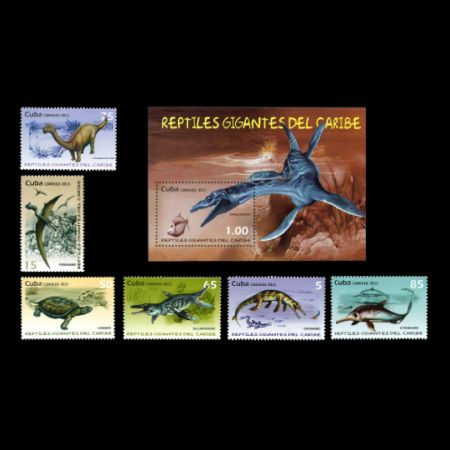
Initially, the Post Authority of Cuba planned to issue the set of 6 stamps and 1 Souvenir Sheet "Giant Reptiles of the Caribbean" on April 3rd, 2013. However, due to some technical reasons the sales of the stamps started half a year later, even though postmark on the FDC remained dated 3/4/2013.
These stamps show prehistoric animals whose fossilized remains have been found on the territory of the island of Cuba.
The Caribbean Zone during the Cretaceous was a marine realm occupied by ammonites, ichthyosaurs, and other sea creatures
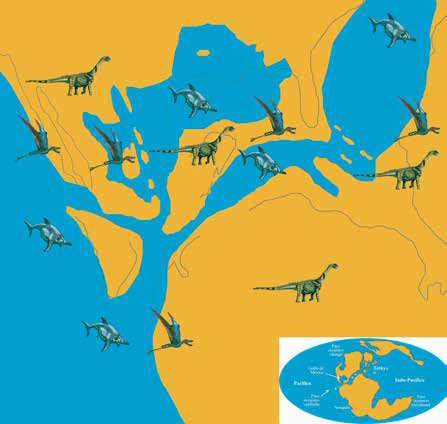 |
|
A paleogeographic map of Cuba during the Mesozoic era.
Image credit "Prehistoricos del Caribe",
by Yasmani Ceballos Izquierdo and Manuel A. Iturralde-Vinent. Similar, but mono-color map was depicted on a cachet of an FDC |
Remains of prehistoric reptiles were found in Cuba during the first half of the 20th century at several localities in the Sierra de los Organos and Sierra del Rosario of the Guaniguanico mountain range, located at the western side of the island.
During the 1990s, Manuel Iturralde-Vinent, from the Museo Nacional de Historia Natural de Cuba, started gathering information about those specimens, and made a detailed catalogue of Jurassic reptile-bearing localities, with a preliminary discussion of the taxonomic position of the previously published taxa. Since the end of the 1990s there has been a close collaboration between Iturralde-Vinent and palaeontologists of the Museo de La Plata, in Argentina, that includes fieldwork, preparation of the specimens and corresponding systematic studies.
Dr. Iturralde-Vinent explained in one of his interviews that the identification of Cuban species is a very complex task, because most fossils are isolated bones and fragments of bones instead of complete skeletons.
This poor preservation is due to the humid climate of Cuba which enhances weathering of these fossils when they are exposed at the surface.
The Souvenir-Sheet shows a long-necked reptile Vinialesaurus, of a plesiosaur from the Late Jurassic Jagua Formation.
The Jagua Formation is a Late Jurassic (middle to late Oxfordian) geologic formation in Pinar del Río Province, western Cuba. Plesiosaur, pliosaur, pterosaur, metriorhynchid, and turtle remains are among the fossils that have been recovered from its strata.
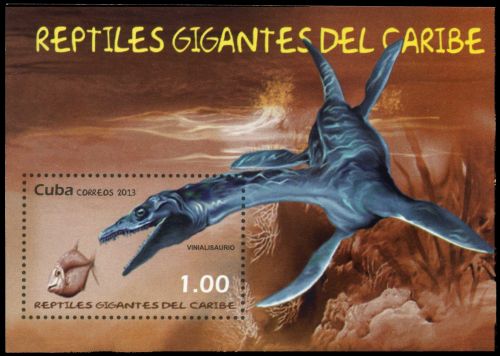 |
| Vinialesaurus on stamp of Cuba 2013, MiNr.: Bl. 299, Scott: 5390s. |
The authors of the 2002 paper considered Vinialesaurus distinct enough from Cryptocleidus to warrant its own genus. The name Vinialesaurus honors Viñales, the town in western Cuba where the fossils were discovered.
The Viñales Valley has been listed as a UNESCO World Heritage Site since November 1999, for the outstanding karst landscape and traditional agriculture as well as vernacular architecture, crafts and music. On of the attraction of the village is Museo Paleontológico. These fossils consist of a mostly complete skull, jaw, and portions of the vertebrae.
The strength of their body and their long, powerful swimming fins suggest that they moved from the depths of the ocean to the coastline. They were endowed with dangerous teeth, with two or three rows of pointed teeth like thorns.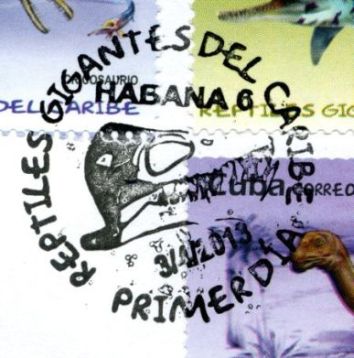 |
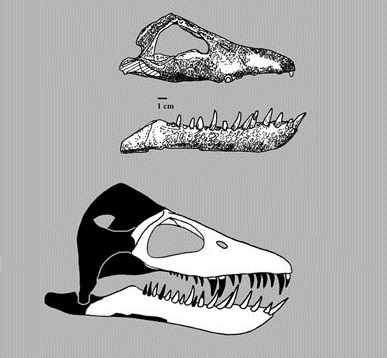 |
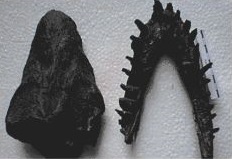 |
|
| Skull of Vinialesaurus on commemorative postmark of Cuba 2013. | Drawing of Vinialesaurus skull. | Skull of Vinialesaurus. Image credit: Fossil Wikia | |
The souvenir sheet shows an example of this behavior - the plesiosaur is shown preying upon a small fish.
Another big marine reptile, shown on the stamps, is Gallardosaurus.
Gallardosaurus is a genus of pliosaurid plesiosaur from the Caribbean Seaway.
The Caribbean Seaway, opened as a corridor only since the Late Jurassic, allowed the exchange of pelagic marine biota between the Western Tethys and the Eastern Pacific realms.
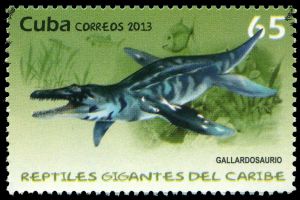 |
| Gallardosaurus on stamp of Cuba 2013, MiNr.: 5681, Scott: 5387. |
The specimen had been discovered in 1946 by Cuban farmer Juan Gallardo about 8 kilometres east of Viñales, Pinar del Río, north-western Cuba, but the specimen was not prepared until 2006. The generic name honors the discoverer (Juan Gallardo who for many years toured the Guaniguanico Mountain Range in Pinar del Río in search of representatives of life in the remote past).
Gallardosaurus iturraldei, is considered one of the greatest predators of the prehistoric Caribbean, since they could feed on any other marine animal of that time. This species probably seasonally migrated across the Caribbean Seaway, while acting as an active predator taking advantage mainly of the large amount of migrating (nectonic) fish.
They hunted by ambush, hiding in the depths and attacking prey that swam close to the surface. Its body was about three or four meters long, with a short neck, a very prominent head and gigantic jaws. Their jaws were endowed with sharp crisscrossed teeth, which prevented the escape of the prey once bitten. It had no enemies, unless it was a very young specimen. The lack of fusion in some of the vertebrae, of the Cuban species, suggests the individual was not fully grown when it died.
The coastal aquatic turtle called Caribemys oxfordiensis or "Caribbean tortoise" was common in the Caribbean Seaway too.
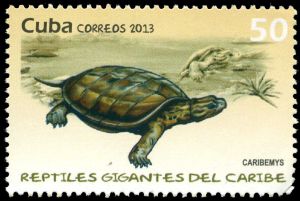 |
| Caribemys oxfordiensis on stamp of Cuba 2013, MiNr.: 5680, Scott: 5386. |
Caribemys was small tortoise, about 35 centimetres long, and it's almost complete skeleton, without the skull, was collected by the peasant and "fossil hunter" Juan Gallardo, near Viñales, in Pinar del Río, back in the 1950s.
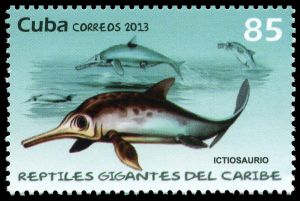 |
| Ophthalmosaurus on stamp of Cuba 2013, MiNr.: 5638, Scott: 5389. |
In the deeper waters, swam icthyosaurs like the species Ophthalmosaurus which were similar to modern dolphins with a tuna-like tail. These animals were actually reptiles though, not mammals.
These were hardy animals, very fast swimmers and endowed with large eyes; That is why they were able to dive to great depths where the luminosity is scarce. They were like the cows of that time because, although they fed on fish and molluscs, they served as food for other reptiles. To date (2013), fossil representatives of at least five ichthyosaurs have been located in the mountains of Pinar del Rio including both skull fragments and body bones.
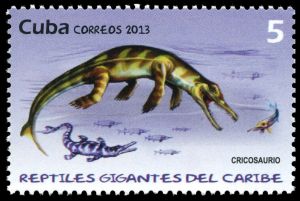 |
| Metriorhynchidae on stamp of Cuba 2013, MiNr.: 5678, Scott: 5384. |
To date (2013), the remains of three individuals have been found in the fossiliferous beds of the Pinar del Rio. Two of the specimens included fragments of the skulls with jaws.
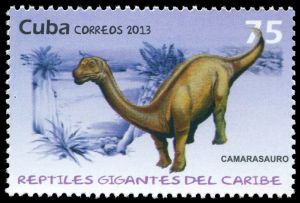 |
| Camarasaurs on stamp of Cuba 2013, MiNr.: 5682, Scott: 5388. |
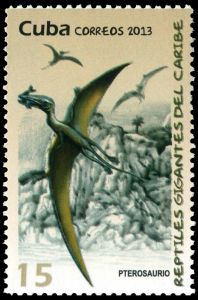 |
| Pterosaur on stamp of Cuba 2013, MiNr.: 5679, Scott: 5385. |
Initially, he thought, the bone belongs to a Brontosaurus or Diplodocus dinosaur. Later on, the bone was identified by Argentinean paleontologist, Dr. Leonardo Salgado, who cooperated with his Cuban colleagues, as a small bone of the hand of some reptile related to Camarasaurs.
Abundant remains of terrestrial vegetation such as fern trees, the fossil remains of at least two species of pterosaurs—extinct flying reptiles—and marine reptile fossils were found in the same strata.
The pterosaurs, Nesodactylus hespericus and Cacibupteryx caribensis, had the ability to travel long distances, both in search of food and to mate.
To catch the fish they made a low flight over the water, and used their jaws and teeth as a net.
The forelimbs of these animals were constituted by membranous wings, supported for the most part by the elongation of the fourth finger.
An exclusive and different way to the design of the wings of birds and bats.
Products and associated philatelic items
| Post-cancelled FDC | First-Day-of-Issue Postmark | Stamp Sheets |
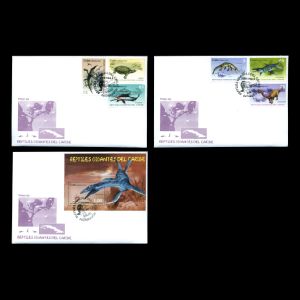 |
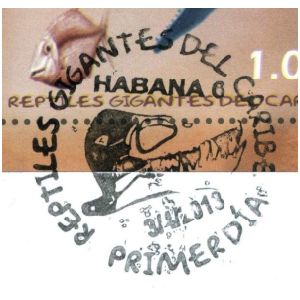 |
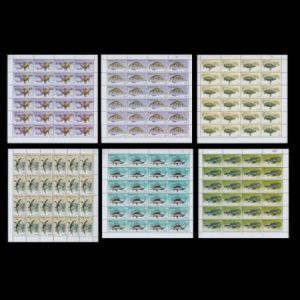 |
| The stamps arrived at post offices in October-November 2013. First day covers were postmarked with the initially planned April 3rd issue date. | ||
| Example of circulated covers | ||
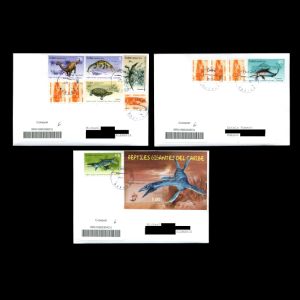 |
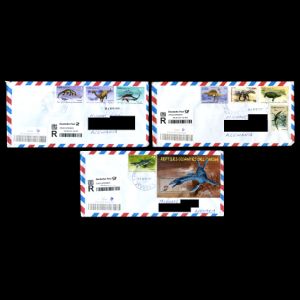 |
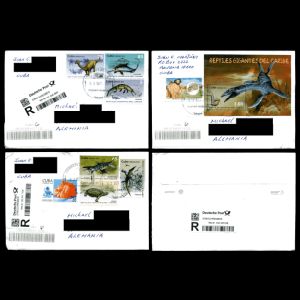 |
| Color variants and perforation errors | ||
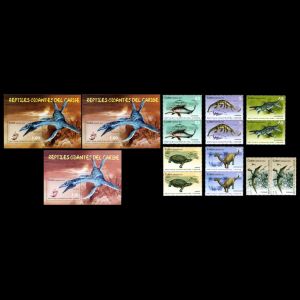 |
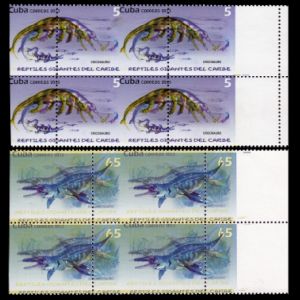 |
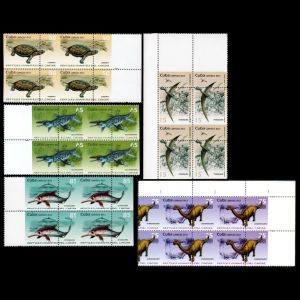 |

|
- Technical details and description of the stamps:
- Filateliadesdecuba
- Juventud Rebelde (interview with Doctor Manuel Iturralde-Vinent, thw president of the Cuban Gological Society)
- Vinialesaurus:
Wikipedia, fossil.fandom. - Gallardosaurus:
Wikipedia,
"A New Oxfordian Pliosaurid (Plesiosauria, Pliosauridae) in the Caribbean Seaway". By Zulma Gasparini - Metriorhynchidae:
Wikipedia. - Camarasaurus:
NHM UK, Wikipedia, Latin American Studies. - Nesodactylus:
Wikipedia. - Cacibupteryx:
Wikipedia.
Acknowledgements:
Many thanks to Dr. Peter Voice, PhD Department of Geological and Environmental Sciences, Western Michigan University, USA, for review of a draft of this article and his very valuable comments.
| <prev | back to index | next> |